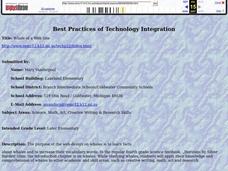Curated OER
Monitoring Energy Expenditure
Students use heart rate monitors and complete a swimming and running test. These tests allow students to obtain personal data, to manipulate the data through calculations of various parameters, and to graphically represent the data.
Curated OER
Cartography
Students follow directions to draw a map of an island. They complete the island map adding their own details using symbols and a legend.
Curated OER
What Does It Eat?
Students use crickets, mealworms, and pill bugs and observe what they choose to eat. In this science lesson plan, students record data, create graphs, and do a write up on what they see happening.
Curated OER
Measure Up!
Students examine parallax and angular measurements. In this investigative lesson students calculate distances of objects and map their results.
Curated OER
Getting Under Your Skin
Young scholars design advertisements that promote and explain the science of new transdermal drug therapies to the general public.
Curated OER
Pi Day (March 14)
Fourth graders determine the value of ? by measuring the circumference and diameter of circular objects such as soup cans, Oreo cookies, etc..
Curated OER
Flour Beetles
Students observe life stages in flour beetles and graph the results. They write a summary report.
Curated OER
Ice Age Animals
Students research the ice age and the animals that were on the Earth at that time and have a debate on the explanation for the extinction of the ice age animals.
Curated OER
Teaching Science with a Smile
Students study science concepts as they are presented in poetic form. They write and present their own science poems to parents during Open House.
Curated OER
Structure of the Earth
Eighth graders examine the forces that are constantly acting on the Earth. They describe the theory of tectonic plates and demonstrate the two kinds of earthquake waves. They also examine the role of volcanoes in the structure of the...
Curated OER
Opinion Surveys
Students examine the factors that affect the accuracy of opinion surveys. They calculate probability and chance using data they have collected. They practice reading tables and graphs as well.
Curated OER
Leonardo Lives
Students investigate the concepts of force and motion. They describe how motion is created by force. Also students define a simple machine and the factors of application to creating force or motion. They analyze the plans of Leonardo De...
Curated OER
Whale of a Web Site
Students compare and contrast differences and likeness of whales/fish and toothed/baleen whales and discuss what they know about whales and what they would like to study about whales. They then describe the characteristics of a mammal.
Curated OER
Territorial Behavior in Crickets
Students explore the behavior of crickets during courtship. They measure the number and types of interactions between household crickets. Students discriminate between quantitative and qualitative observations. They collect data to...
Curated OER
Kites
Students build a kite while integrating math and science. In this kite building lesson, students construct a blueprint and apply mathematical formulas while constructing a kite. They use appropriate flight and kite terminology to...
Curated OER
Gymnastics Lesson
Students investigate the importance of having a healthy body by performing gymnastics. In this physical education lesson, students utilize their flexibility and body strength to perform intense physical gymnastic maneuvers with the help...
Curated OER
The Seasons
Second graders determine the ways in which deciduous trees lose their leaves by investigating fallen leaves and how the weather changes throughout the seasons. They obtain knowledge about why and what causes the weather to change...
Curated OER
Monomer and Polymer Chemistry
Students explain monomer/polymer chemistry of starches and sugars.
Curated OER
Epidemiology: Graphing and Analyzing Health Data
Learners graph data on fetal and infant mortality rates collected by the Centers for Disease Control and Prevention. They identify trends in the data and propose potential causes for the trends.
Curated OER
Investigating the Biosphere With Planetary Models
Learners create a biosphere using the computer program SImEarth. They work in small groups to create "Daisyworld" in which they model aspects of the Gaia hypothesis. They form a question to answer and choose variables to investigate in...
Curated OER
Chapter 15: Science and the Mass Media
In this science and mass media in America worksheet, high schoolers complete 12 fill in the blank questions and 6 multiple choice questions regarding the culture of United States
Curated OER
Aerospace
Students experiment with weight and balance of a glider. In this flight lesson students construct their own flying glider and record their experiment with it.
Curated OER
Center of Gravity
Seventh graders determine the center of gravity of an object. They get card stock objects to balance on pencil eraser and a meter stick to balance with same # of weighted string(s) on each side. They get meter stick to balance with...
Curated OER
SEM/EDS Beach Sands
Students pose a question that can be answered using the SEM and sand they collected from beach profiles. Then, they use the SEM to answer their question or test their hypothesis. Students design a small testable project and demonstrate...

























